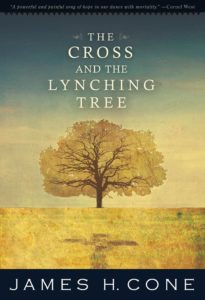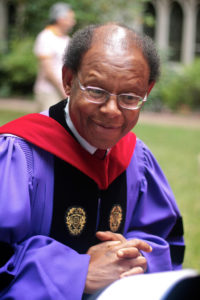The Cross and the Lynching Tree: A conversation
We invite you to study, engage, and reflect with us as we read and discuss James Cone’s challenging and important work, The Cross and the Lynching Tree. We encourage you to reach out to us directly with your thoughts, questions, and criticisms. Below are some questions and concerns that might come up.
— Matt Logan, Director of Discipleship and Young Adult Ministry, and Keith Dove, Sid & Cathy Batts Pastoral Resident
This series was published while the church campus was closed during the COVID-19 stay at home order.
 Is this engagement proper during our current situation?
Is this engagement proper during our current situation?
Those who were going to help facilitate the discussion (us) had read and engaged with the text before the quarantine was announced. Our correspondence is just a recording of the things we had already discussed. It wasn’t as if when social distancing measures went into effect, we thought this would be the perfect book to read and discuss. Instead, we decided that the church should continue to educate, pray, think, and act in ways that address the sin of racism. It is also an invitation to think and pray about the fact that when catastrophic events occur, it is typically the most marginalized that are the most heavily impacted. The current pandemic included.
Who is James Cone? Why should I read this?
 We cannot overstate how important Cone and his work has been for thinking about Christianity and Race in America. Even if you have never heard of Cone or have never read a sentence that he has written you have probably experienced his influence. The closest parallel you may be familiar with would probably be Reinhold Niebuhr. Where Niebuhr has been the most influential theological voice in mainline Christianity, Cone shares the same influence inside the black church in America. You should read this and engage with this text because I have no doubt it will challenge you. You may not agree with everything Cone writes. You may even be offended or feel like you are being accused. This book will unveil to you the major differences that still exist between a predominantly white theological vision and one that has its lineage in the oppression that black Christians have historically endured. However, it doesn’t stop there. It provides a Christian and moral imperative to continue to strive for justice as God’s people, black and white. It may open your eyes to questions and problems you may not have been aware of previously.
We cannot overstate how important Cone and his work has been for thinking about Christianity and Race in America. Even if you have never heard of Cone or have never read a sentence that he has written you have probably experienced his influence. The closest parallel you may be familiar with would probably be Reinhold Niebuhr. Where Niebuhr has been the most influential theological voice in mainline Christianity, Cone shares the same influence inside the black church in America. You should read this and engage with this text because I have no doubt it will challenge you. You may not agree with everything Cone writes. You may even be offended or feel like you are being accused. This book will unveil to you the major differences that still exist between a predominantly white theological vision and one that has its lineage in the oppression that black Christians have historically endured. However, it doesn’t stop there. It provides a Christian and moral imperative to continue to strive for justice as God’s people, black and white. It may open your eyes to questions and problems you may not have been aware of previously.
Do I need to read the book to follow the conversation?
In this case, you probably do. Regardless, we invite you to take part. If you read our conversations and you think we are being harsh or unfair, it is important to remember that we are committed to engaging with the text. Neither of us tries to shy away from the questions that Cone presents. We are attempting to honestly engage with his thought and work and to find our place in his argument. If you find that we are speaking in generalities or are not being entirely disciplined, it is probably because we are using the grammar that Cone gives us. I think you will find that we have taken Cone at his word in a lot of cases. We have been hospitable, we have avoided getting defensive, and we intentionally prevented ourselves from romanticizing any aspect of the history of racial violence in America.
What would be your pitch for me to read along with you?
Many times, when churches talk about or address race they forget to talk about the church. We mean, that race and racial conflict are often trivialized into political talking points and addressed in ways that deny the specific role the church must play to address the sin of racism. This book is specifically about the church and its history. It is about recognizing that Sunday is still the most segregated day of the week. It looks at what religious symbols and language might mean for people who have experienced the world differently. However, what we think it does best, is that it doesn’t let you off the hook. It is real. It is convicting. It is explicitly Christian. It is extremely important.
THE CONVERSATION
Invitation
Introduction and Chapter 1: “Nobody Knows de Trouble I See”
Chapter 2, “The Terrible Beauty of the Cross”
Chapter 3, “Bearing the Cross and Staring Down the Lynching Tree”
Chapter 4, “The Recrucified Christ”
Chapter 5, “Oh Mary, Don’t You Weep”
